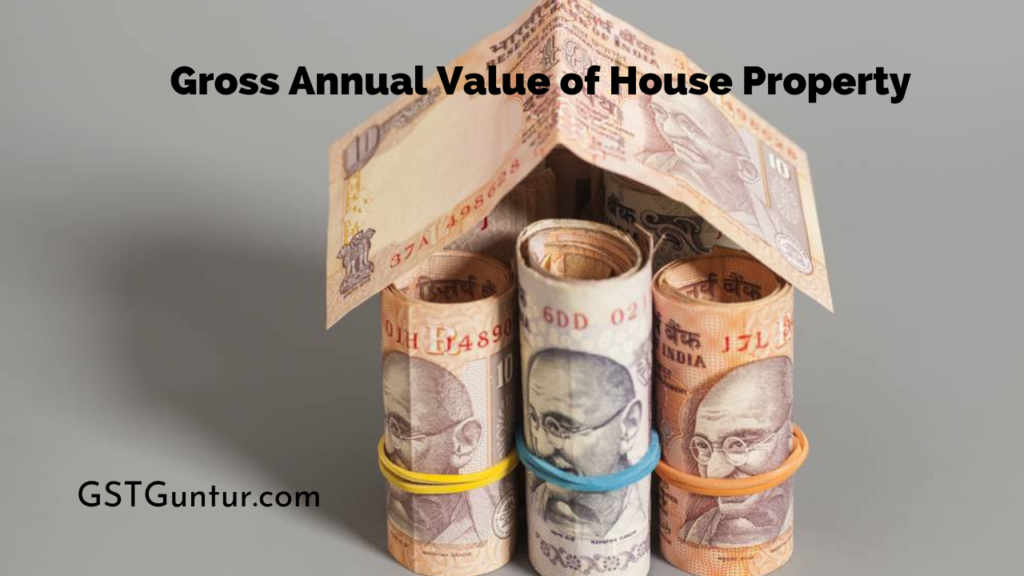What is the Gross Annual Value of House property?
The tax revenue that may be made from immovable property is defined as the gross annual value (GAV). GAV will implement regardless of whether the property is rented out for business or residential usage.
Section 23 clearly states that revenue from residential housing is taxed as income annually.
Even if the residential property is not rented out for the entire year or is merely rented out for a small portion of the year, the notional Rent due is chargeable to taxation as its yearly worth.
- What is the Gross Annual Value of House property?
- What Exactly Is House Property?
- Other Factors to Take into Consideration
- Gross Annual Value of House Property Criteria
- How Gross Annual Value of House Property is Calculated?
- Calculation of the Annual Value
- Scenarios of House Property
What Exactly Is House Property?
The following components are included in a house property:
Dwelling Residence, small shops, Godown, Theater Complex, Workshop plot, Hotel Land, so on and so forth.
Before determining the gross annual value or the net annual value, these points must be fully grasped:
- Suppose the landowner has only a single asset and is self-occupied for household use. In that case, the Gross Annual Value (GAV) and Net Annual Value (NAV) is computed as Zero because you are not deriving any additional revenue from it.
- If the individual has only a single asset and is reasonably placed distant from his or her current workplace, the Gross Annual Value and Net Annual Value are evaluated as NIL if no revenue is obtained from that residential property.
- As per the Income Tax Act, if the owner currently acquires more than one self-occupied residential property, but only one is maintained for private purposes, the other properties shall be regarded as “deemed to be let out” because you can’t live in two houses simultaneously and have to assess and pay taxes on it.
- As previously indicated, the Annual Value is zero in the case of a single self-occupied household. Tax deduction for interest paid under section 24 could still be claimed.
The consequent loss can be offset against other types of income, but it cannot be essentially be carried forward.
Section 24 permits a person to make a claim of exemptions on the interest paid on a house loan.
To claim this deduction, you must complete all three of the following conditions:
- The loan was issued after April 1, 1999, for the specific purpose of acquisition or building.
- The purchase or building is finished within five years after the end of the financial year in which the loan was legally obtained.
- There is interest documentation readily available for the loan’s interest received.
Bear in mind that if any of these conditions are completely met, your interest deduction may be restricted to Rs 30,000.
- Before April 1, 1999, the loan was obtained for the buying, building, repair, or reconstruction of a property.
- The loan was easily obtained on or after April 1, 1999, to buy, construct, renovate, or rebuild the property.
Other Factors to Take into Consideration
- You could deduct pre-construction interest if you borrowed money to buy or build a residence. This is not permitted in the event of a loan for renovations or rebuilding. Pre-construction interest is deductible in five equal payments beginning with the year construction is successfully completed.
- Municipal taxes can only be deducted if they were paid by the owner during that budget year.
- The standard deduction is 30% of the above-mentioned Net Annual Value. This 30% deduction is granted regardless of whether your total expenditure on the property is significantly larger or considerably lower.
- If the current owner or family dwells in the house property, the owner or his family are eligible to claim a tax deduction of up to Rs.2 lakh on their home loan interest, i.e., The exemption for interest on a home loan is restricted to a maximum of INR 2,00,000 in the context of self-occupied property.
- When the house, is uninhabited the same technique is often used. If you rented out the property, you could deduct the entire interest on the house loan literally.
Gross Annual Value of House Property Criteria
The following criteria evaluate the gross annual value of a house:
- The actual Rent received/receivable is the Rent received or out to be received by the landlord of the residential asset when the house property is rented off.
- Municipal value is the value evaluated by municipal authorities for the specific reason of enforcing municipal taxes on real estate. Municipalities often levy home tax/municipal taxes dependent on the yearly letting value of such residential property.
- A fair rent is a Rent that a roughly comparable property in the exact or pretty similar neighborhood may command.
- The Rent Control Act specifies a standard rate where the owner cannot claim a substantially increased rate than the standard Rent.
- Expected Rent is the greater of the municipal value and the fair Rent, limited to an absolute max of Standard Rent.
For illustration, in this case, we will consider that the rent values are:-
Fair Rent = Rs 15,000*12 = 1,80,000
Municipal Value = Rs 10,000*12 = 1,20,000,
Standard Rent = Rs 20,000*12 = 2,40,000
Actual Rent Rs = 18,000*9 = 1,62,000

How Gross Annual Value of House Property is Calculated?
Let us check how the Annual Value Of House Property is calculated:
- Firstly, directly compare and contrast Fair Rent and Municipal Value and then choose the greater of the two. You will get a Reasonable Expected Rent.
We can simply logically deduce from the given numbers that – of the two options, fair Rent and municipal Rent – fair Rent is greater, i.e., Rs 1,80,000, consequently we will be using fair Rent as the reasonable expected Rent.
- Now, check Reasonable Expected Rent against Standard Rent and then choose the lowest of the two to find the Expected Rent (also known as Annual Letting Value).
In this particular case, the reasonable expected Rent is less than the standard Rent, which is Rs 1,80,000.
- Now, evaluate your Expected Rent to your Rent Received, Receivable, or Actual Rent, and choose the one which is the highest number of the three to determine the Gross Annual Value of your home accurately.
In this case, especially, the expected Rent is greater than the actual Rent, which is Rs 1,80,000.
Now that we have the GAV or Gross Annual Value of a property, which is Rs 1,80,000, we must approximate the NAV or Net Annual Value or Annual Value of your land.
Calculation of the Annual Value
Based on Section 23(1)(a) of the Income Tax Act, the Annual Value of a Home is the amount of money for which the residential property may reasonably be expected to be rented year after year.
The Net Annual Value, or NAV, is the difference between the Gross Annual Value and the Municipal Taxes.
To compute NAV, use the following formula:
NAV = GAV – Municipal Taxes
In the preceding example in this case,
Gross Annual Value = Rs 1,80,000
Municipal Value = Rs 1,20,000,
Therefore, NAV= Rs (1,80,000-1,20,000)
= Rs 60,000
Scenarios of House Property
When it concerns renting out the property, there are three primary scenarios:
- Option 1: When a house is rented out for the whole previous year.
- Option 2: When a residence is rented out and has been empty for the majority or a significant portion of the preceding year.
- Option 3: When the house property is rented out for a part of the year and inhabited for the vast majority of the rest of the year.
